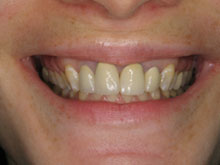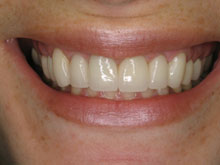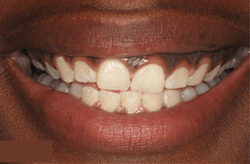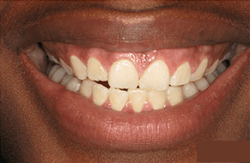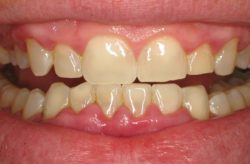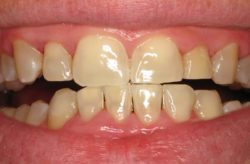Treating Periodontal Disease
If you have recently been told by your dental professional that you have been diagnosed with periodontal disease, you are not alone. Also known as gum disease, Periodontal disease is a condition that affects several Americans over the age of 30. When periodontal disease is left untreated, it progresses to a more severe stage known as periodontitis. It involves painful inflammation of the gums, causing them to appear red, swollen, and bleeding.
Periodontitis leads to severe complications such as tooth loss. This is the outcome most try to avoid, and luckily with the many advancements in dental technology and periodontitis treatment, tooth loss can be avoided. On this page, we will go into full detail about our periodontal disease treatment options. Our #1 priority is to ensure our patients are thoroughly informed and receive the proper quality treatment they deserve.
Periodontal Disease And The Importance of Treatment
Periodontal or gum disease is a prevalent but preventable infection that damages the soft tissue and, when left untreated, can deteriorate the bone that supports the teeth. Once the infection attacks the supporting bone, it can cause teeth to loosen and eventually complete tooth loss. Healthy gum tissue is pink in color and firm and fits tightly around the tooth. When gum disease is present, common signs and symptoms include swollen or inflamed gums, gums that bleed easily, gums that pull away from the teeth, and several more.
It is critical to treat periodontal disease because if the condition is not addressed earlier, then it will progress to a more serious case. Therefore, making it more challenging to treat. Periodontal treatment can benefit patients in several ways. The main goal of periodontal disease treatment is to restore optimal dental health. Treatment encourages the formation of new healthy gum tissue and regeneration and allows the gum tissue to securely and tightly attach to the teeth’s surface.
Periodontal disease can cause significant discomfort in the mouth. The infectious disease-causing bacteria causes the gums to become swollen and painful throughout the day and bleed while brushing. Treatment will help to minimize and eventually stop these symptoms.
Treating periodontal disease also helps to prevent more significant dental complications from occurring. Due to the high level of bacteria present in the mouth, patients with gum disease are likely to develop tooth decay. Research shows that gum disease and health directly correlate with overall health. Gum disease patients have an increased risk of cardiovascular disease, diabetes, stroke, and respiratory disease.
The sooner you seek treatment, the better your chances of saving your teeth and overall health.
Diagnosis
In order to properly treat your gum disease, there are several factors that our Periodontists take into account. To determine if you have gum disease and the severity of the disease, our specialists may:
- Examine your personal health history.
- Examine your mouth.
- Measure the gum pocket depth.
- Take dental x-rays.
Medical History
Our Periodontists will examine your personal health history to identify if any factors contribute to your current gum disease condition. Factors such as smoking tobacco, diabetes, genetics, or certain medications can cause dry mouth.
Examine the Oral Cavity
An oral examination is performed to look for any signs and symptoms of gum disease. Signs and symptoms include plaque and tartar buildup and bleeding. Sensitivity and pain to touch are also common. In its more advanced stages, loose teeth and abscesses in your gums may be present.
Measure the Gum Pocket Depth
Our specialists will use a dental probe to insert between the gum line and the tooth’s surface during this examination step. The dental probe is designed to measure the depth of the gum pockets. The pocket depth in a healthy mouth typically measures between 1 and 3 millimeters (mm). The gum pocket measures 4 millimeters or more when gum disease is present.
Dental X-Rays
Dental X-ray images are an effective diagnostic tool that allows our specialists to see any damage or disease that is not visible to the naked eye. We check these images for bone loss where deeper pocket depths are present.
Periodontal Disease and its Stages
Periodontal disease is the result of infections and inflammation of the gums due to bacteria in the mouth. This bacteria infects the tissue that surrounds the tooth. Once the bacteria accumulate in these areas, it causes inflammation around the tooth, leading to periodontal disease. Periodontal or gum disease has many stages. In its earliest stage, it is known as gingivitis. When gingivitis progresses, it advances to periodontitis. Periodontitis itself has several stages. Below are in-depth summaries of each stage of periodontal disease.
Gingivitis
Gingivitis is the very early stage of gum disease. During this stage, the gums and surrounding tissue are inflamed and sensitive. Although the gums are irritated during this stage, the teeth are still firmly stable in their sockets. The damage caused by gingivitis can also be reversed with proper oral hygiene maintenance and regular dental checkups. Common symptoms of gingivitis include:
- Bleeding while brushing or during probing
- Possible bad breath and/or a bad taste in the mouth
Mild Periodontitis
Mild periodontitis is a slightly more severe form of gingivitis. During this phase, there is more pronounced gingival bleeding and swelling. The gum tissue may begin to pull away from the teeth, forming small pockets. Pockets collect any food particles and debris which can cause infections. Symptoms of mild periodontitis include:
- Bad breath and/or a bad taste in the mouth
- Pockets measure 3-4 millimeters deep
Moderate Periodontitis
When gingivitis is left untreated, it can progress to moderate periodontitis. During this stage of gum disease, the gum layer attached to the teeth begins to pull away, forming slightly deeper pockets, which can cause moderate bone loss. The pockets can measure between 4-6 millimeters deep, and teeth tend to look longer due to gum recession. Other symptoms include:
- Gum boils or abscesses may develop
- Possible bad breath and/or a bad taste in the mouth
- Teeth may begin to drift and show spaces
Advanced Periodontitis
Advanced Periodontitis is the most severe stage of gum disease. The pocket size is now 6 millimeters or more profound, and severe bone loss exists. Due to the enlarged pocket depth and bone loss, teeth may become loose or mobile. This will affect the bite alignment; teeth may have to be extracted if treatment is ineffective. Other symptoms of advanced periodontitis include:
- Constant bad breath and/or a bad taste in the mouth
- Teeth sensitivity due to exposed roots
Signs of Periodontal Disease
Our gums are a key part of our oral and overall health. They deserve as much attention as any other body part. When they aren’t taken care of, it can lead to dental complications. The most common condition associated with poor oral hygiene is periodontal disease. Regular signs to look out for regarding periodontal disease include:
- Experiencing bleeding when brushing and flossing. Bleeding is one of the earliest symptoms of gum disease. This is a warning sign that you are beginning to develop gum disease.
- Another common sign is swelling and redness. This redness or swelling can be across the gum line or in an isolated area. The area may be sensitive to touch and extreme temperatures. You may experience an ache when exposed to hot or cold liquids or foods.
- A receding gum line is a symptom that appears when your periodontal disease has progressed to a more serious stage. Once the gum tissue begins to recede, it may cause the tooth to appear longer and leave the tooth’s root exposed.
- Bacterial infections formed below the gum line cause the formation of periodontal pockets. These pockets cause the gum tissue to separate from the tooth’s surface and root. This can lead to tooth decay, and you may begin to experience pain, sensitivity, and tooth movement.
Periodontal Disease Treatment Options
Periodontal disease treatment is typically performed by a Periodontist, dentist, or dental hygienist. The main objective of gum disease treatment is to thoroughly clean the gingival pockets where harmful bacteria accumulate. Removing the accumulated bacteria and sterilizing the site helps to eliminate and reduce the production of periodontal disease. There are numerous ways our Periodontists can treat gum disease. Treatment depends on the disease stage, how your body reacted to previous treatment and overall health.
Nonsurgical Treatment Options
Depending on the severity of your case, you may be a candidate for nonsurgical periodontal treatment. There are several treatment options that are minimally invasive and fully treat periodontal disease. However, if the nonsurgical treatment does not achieve optimal periodontal health, we may recommend a more extensive treatment such as gum surgery.
Dental Scaling
Everyone accumulates some amount of plaque buildup on the tooth’s surface. The saliva, bacteria, and proteins from our foods form a thin layer covering your teeth. Practicing proper dental hygiene, such as brushing and flossing, is key to helping remove the plaque and preventing more serious complications.
Dental scaling is the first treatment step if your case is beyond gingivitis. Dental scaling goes much deeper than dental cleaning. It is performed before other treatments to remove the disease-causing bacteria. Dental scaling involves carefully removing dental plaque and tartar buildup from the tooth’s surface and below the gum line. This process is known as deep cleaning.
During dental scaling, our Periodontists will use a handheld tool known as a dental scaler and curette to scrape the plaque from the tooth’s surface gently. Your specialist will insert the tool between the gum line and the tooth to reach the plaque your normal toothbrush cannot access. We may also choose to use an ultrasonic tool to scale your teeth, featuring a vibrating metal tip combined with a cool water spray to flush out the periodontal pockets thoroughly.
Dental scaling is normally followed by root planing, which accesses plaque located much deeper than dental scaling. Root planing removes the plaque from the tooth’s root to allow the gums to reattach properly.
Root Planing
Once the tooth’s surface is clean and all plaque has been removed, we work down to the tooth’s root. Root planing is a procedure that involves the removal of plaque and tartar that has accumulated on the tooth’s root. Removing this bacterial plaque promotes healthy and proper gum tissue reattachment to the tooth’s surface.
Dental scaling and root planing (SRP) can take several visits to complete. The amount of visits depends on the severity of the gum disease case. Our specialists will first use a special handheld tool to push the gum tissue aside and expose the tooth’s root during this procedure. Once the root is exposed, we then use the same dental scaling tool to gently chip away the tartar and plaque buildup, producing a smooth finish. We may inject antibiotic medications directly into the gum pocket depending on the case.
LANAP Therapy
Laser therapy is one of the most advanced and innovative methods of treating periodontal disease. We utilize state-of-the-art laser technology, known as the PerioLase, to remove the infection-causing bacteria with little to no discomfort. With the laser-assisted-new-attachment procedure (LANAP), our Periodontists will utilize a laser to precisely target and remove the diseased tissue. No need to worry about scalpels to painfully remove the gum tissue.
This innovative technology allows our specialists to effectively and efficiently treat periodontal disease less invasively and with a shorter recovery time. Our specialists use the PerioLase laser to direct the pulsed laser at the affected gums. The LANAP procedure takes about 3 to 4 hours to complete, and you can expect 1-2 treatments compared to multiple sessions with more invasive treatments. This means you can receive treatment and do your daily activities the same day, experiencing little to no pain.
Antibiotics
Gum or periodontal disease can be treated by antibiotics. However, it is not recommended as the sole treatment. Antibiotic treatments come in several different forms. These forms include oral and topical antibiotics that are directly applied inside the gum pockets. Antibiotics are proven to help reduce inflammation and eliminate the bacterial growth that causes periodontitis. Antibiotic therapy is recommended for those who suffer from acute periodontal disease or gingivitis. There are stronger forms of antibiotics that are used more on patients who suffer from more advanced forms of periodontal disease. Common antibiotics prescribed to treat the periodontal disease include:
- Tetracycline Antibiotics. Antibiotics that include tetracycline hydrochloride, doxycycline, and minocycline have antibacterial properties that reduce inflammation and block collagenase. Collagenase is a protein that destroys connective tissue and bone.
- Amoxicillin. This is a commonly used antibiotic only used to fight bacterial infections and harmful bacteria. Amoxicillin does not eliminate the bacteria but aids in preventing the microbes from forming walls around them, which is how bacteria reproduce and survive.
- Metronidazole. This antibiotic is combined with amoxicillin or tetracycline to fight bacterial growth and inflammation in patients who suffer from advanced periodontitis.
- Macrolide Antibiotics. This combination of antibiotics effectively reduces inflammation and stops bacterial growth associated with periodontal disease.
- Azithromycin. This antibiotic has proven to reduce the growth of bacteria that are associated with periodontal disease and is commonly used to reduce inflammation.
- Ciprofloxacin. This antibiotic is used to target a bacteria known as actinomycetemcomitans specifically. This is a slow-growing but harmful bacteria that promotes gum disease.
- Clindamycin. This antibiotic is used to treat several types of bacterial infections. Clindamycin helps stop the development of harmful bacteria.
Surgical Treatment Options
Some patients require a more advanced treatment option. Surgical treatment options are typically performed on patients with the most advanced periodontal disease cases. In these cases, you will find that the patient’s teeth and jawbone are completely compromised.
Guided Tissue Regeneration (GTR)
Guided tissue regeneration (GTR) is a surgical procedure that is performed on patients whose supporting jawbone and teeth have been destroyed by disease-causing bacteria. The main goal of this treatment is to repair the bone damage done by periodontal disease so that the teeth have more support and stability in the mouth. This technique helps stimulate new healthy bone and gum tissue growth.
Our Periodontists will first perform surgery on the affected gum tissue and bone during the guided tissue regeneration procedure. This technique is typically combined with flap surgery. Flap surgery is what opens the gum tissue and provides access to the damaged tissue and bone. Once the bone is exposed, our experienced specialists will clean out the area under the gum by scaling and root planing to remove the bacteria deposits.
We then insert a resorbable or non-resorbable membrane over the compromised bone. The membrane placement between the gum tissue and bone provides the required space and adequate time for regrowth and healing. This membrane is vital as it prevents the faster soft tissue cells from growing while allowing the slower-migrating bone cells to reproduce.
Once the surgical site is fully healed, the membrane and stitches either dissolve or are removed. New attachments and bone regeneration typically take up to six months to fully support the affected tooth or teeth. If you receive this treatment, it is essential to carry on with your daily oral hygiene practices to decrease your chances of any complications associated with periodontal disease.
Flap Surgery (Pocket Reduction Surgery)
Flap surgery or pocket reduction surgery is a more invasive version of dental scaling and root planing. This treatment must be performed by a Periodontist. During flap surgery, scalpels are used to make incisions to lift back the gum tissue and expose the tartar buildup. The tartar is then removed, and in some complicated cases, the irregular surfaces are smoothed out to prevent disease-causing bacteria from producing in those rough areas.
We then place the gum tissue tightly against the tooth aiming to reduce the space between the two areas. This open space is known as a pocket. Eliminating this pocket space is also done to reduce any open areas where harmful bacteria can grow and lead to periodontal disease.
Soft Tissue Grafting
Oftentimes, in advanced cases of periodontal disease, patients experience gum recession. Gum recession is when the tissue begins to recede and begins to expose the tooth’s root. This causes the teeth to become hypersensitive to hot and cold foods and beverages, creating space for bacteria to grow, making decay more prevalent.
Soft tissue grafting is necessary to treat gum recession. This procedure supports thin gums or fills in spaces where gum recession is present. Our specialists will take soft tissue grafts, normally from the roof of the mouth, and stitch the tissue into place over the affected area. We administer a local anesthetic to our patients during the procedure to provide comfort. The main types of soft tissue grafting include:
- Connective Tissue Grafting. Connective tissue grafting is one of the most common soft tissue grafting techniques. It involves creating a small flap on the roof of the mouth to take that healthy tissue from underneath. That tissue is then placed on the affected area to promote healthy tissue regeneration.
- Free Gingival Grafts. This process also involves taking healthy tissue from the roof of the mouth. However, instead of taking the healthy tissue from underneath, our specialists use the tissues from the top of the palate. This procedure is recommended for patients with thin gums.
- Pedicle Grafts. Our specialists will take surrounding tissue to cover the exposed root rather than taking healthy tissue from the roof of the mouth. Utilizing the surrounding tissue helps to restore the gum line without using tissue from another area of the mouth.
- Chao Pinhole Technique. This is a minimally invasive gum rejuvenation technique to treat gum recession. Unlike traditional tissue grafting techniques, Chao Pinhole involves no incisions or sutures! This technique uses a needle to make a small hole in the existing gum tissue. The gum tissue is loosened using special instruments, and a collagen membrane is placed to stabilize the gums. The tissue is then expanded to cover the exposed root structure, resulting in a fuller and aesthetically pleasing smile. This technique can be used to treat multiple teeth during the same appointment.
Dental Bone Grafting
Serious complications can be the result of untreated periodontal disease. When left untreated, the disease can spread to deep areas below the gum line and affect the tooth’s root and the jawbone. When the infection becomes aggressive, and the jawbone is compromised, it causes the jawbone to deteriorate, decreasing the support and stability the teeth need to stay in place.
Dental bone grafting is an extremely common procedure that adds thickness and volume to your jaw in areas where bone deterioration has occurred. The bone graft material is normally taken from your own body, which is called autogenous, or in some instances, it may be retrieved from a human tissue bank, known as allografting.
Just like soft tissue grafting, once the bone graft is placed, it acts as a place for your own body to begin regenerating new and healthy bone. There are different forms of bone grafting, including:
- Socket Preservation. This form of bone grafting, sometimes called ridge preservation, is when the grafting material is inserted immediately after a tooth has been extracted. The bone grafting material fills the space where the tooth once stood and prevents the walls of the socket from caving in.
- Ridge Augmentation. It is extremely common for gum disease patients to lose teeth. If the teeth have been missing for a while, the supporting jawbone may begin to thin out and deteriorate. Ridge augmentation helps increase the jawbone’s width and density to provide a stable foundation for a dental implant or other restorative options.
Before performing the procedure, our specialists will perform an oral examination to check the state of your health, gums, teeth, and jaw. Dental X-rays will be taken to determine how advanced your bone loss is. We first numb the area with a local anesthetic during dental bone grafting. An incision is then made to clean out the bacteria, disinfect the area, and insert the bone grafting material to repair the defect. Finally, the gum tissue is repositioned back into place and closed with stitches
Treatment Aftercare
Aftercare maintenance is vital to ensure everything heals properly following your treatment. Following any dental procedure, it is common to experience some discomfort when eating cold or hot foods or drinking cold or hot liquids. Sensitivity is the most common side effect following periodontal treatment due to removing tartar and exposing a small amount of the tooth’s root. This sensitivity may linger for a few days but tends to fade gradually within a few weeks. Below are some steps you can take to help minimize any of these inconveniences:
- Eat a healthy, well-balanced diet. Avoid consuming cold and spicy liquids or foods for a few days after treatment.
- Avoid smoking tobacco products to reduce infections.
- You may rinse with warm salt water within the first 24-48 hours to ensure your mouth remains clean from bacteria.
- Use over-the-counter pain medication to help manage the pain and discomfort you may experience.
- In some cases, antibiotics may be prescribed to prevent infections. You must take the antibiotics according to the instructions and schedule.
- It is normal to experience swelling near the treated site. You may place an ice pack on your cheek to help manage the swelling. However, if the swelling worsens, you must contact one of our specialists.
- You may expect slight bleeding for up to 48 hours following your treatment. This is normal. However, if the bleeding persists for more than 48 hours, contact one of our dental professionals.
- You may also protect your restored gum line by wearing a mouthguard at night to prevent teeth grinding and clenching.
Most periodontal treatments involve removing harmful bacteria, regenerating healthy tissue, and creating new attachments between the tissue and the tooth’s surface. Therefore, it is essential to keep the affected area clean and bacteria-free following the procedure. This will allow for proper and healthy recovery.
Prepare for your Appointment
Now that you are fully informed about periodontal disease treatment options let’s help you take the next step. Going into your dental appointment fully aware of your treatment options helps you know what to expect and what questions you may want to ask. Each patient is dealt with on a case-by-case basis, and we understand that not all cases of periodontitis are identical. For some, the benefits of one treatment option outweigh the benefits of other options. We are here to help you find the perfect treatment solution for you!
To prepare for your appointment, it may be beneficial to make a list of:
- Any symptoms you have been experiencing. These may include any that seem unrelated to the reason for your appointment.
- Have your personal information ready, such as any medical conditions you have had or currently have.
- Bring a list of all your medications, including vitamins, over-the-counter medications, or other supplements.
If you have any questions leading up to your appointment, have them listed and ready to be asked to make the most of our time together. Common questions you may want to ask our specialists regarding your treatment are:
- What is the likely cause of my symptoms?
- What are my treatment options?
- How long will treatment take?
- What kind of examinations, if any, are needed?
- What proactive steps can I take to keep my gums and teeth healthy at home?
- Does my insurance cover treatment?
Our specialists are eager to help you with any of your dental needs. We are here for you every step of your treatment process and will help guide you. To schedule a consultation or for more information about treating periodontal disease, call us at (877) 440-3564. We look forward to helping you smile!
FAQ
-
What is gingivitis?
Gingivitis is the very early stage of gum disease. During this stage, the gums and surrounding tissue are inflamed and sensitive. Although the gums are irritated during this stage, the teeth are still firmly stable in their sockets. The damage caused by gingivitis can also be reversed with proper oral hygiene maintenance and regular dental checkups.
-
What is LANAP?
Laser therapy is one of the most advanced and innovative methods of treating periodontal disease. We utilize state-of-the-art laser technology, known as the PerioLase, to remove the infection-causing bacteria with little to no discomfort. With the laser-assisted-new-attachment procedure (LANAP), our Periodontists will utilize a laser to precisely target and remove the diseased tissue. No need to worry about scalpels to painfully remove the gum tissue.
-
How do I know if my gum disease is severe?
Advanced Periodontitis is the most severe stage of gum disease. The pocket size is now 6 millimeters or more profound, and severe bone loss exists. Due to the enlarged pocket depth and bone loss, teeth may become loose or mobile. This will affect the bite alignment; teeth may have to be extracted if treatment is ineffective.
-
What is the best treatment for severe gum disease?
The most efficient treatment options for an advanced case of periodontitis include:
- Flap Surgery. Flap surgery or pocket reduction surgery is a more invasive version of dental scaling and root planing. This treatment must be performed by a Periodontist. During flap surgery, scalpels are used to make incisions to lift back the gum tissue and expose the tartar buildup. The tartar is then removed, and in some complicated cases, the irregular surfaces are smoothed out to prevent disease-causing bacteria from producing in those rough areas.
-
- Chao Pinhole Technique. This is a minimally invasive gum rejuvenation technique to treat gum recession. Unlike traditional tissue grafting techniques, Chao Pinhole involves no incisions or sutures! This technique uses a needle to make a small hole in the existing gum tissue. The gum tissue is loosened using special instruments, and a collagen membrane is placed to stabilize the gums. The tissue is then expanded to cover the exposed root structure, resulting in a fuller and aesthetically pleasing smile. This technique can be used to treat multiple teeth during the same appointment.
- Guided Tissue Regeneration (GTR). Guided tissue regeneration (GTR) is a surgical procedure that is performed on patients whose supporting jawbone and teeth have been destroyed by disease-causing bacteria. The main goal of this treatment is to repair the bone damage done by periodontal disease so that the teeth have more support and stability in the mouth. This technique helps stimulate new healthy bone and gum tissue growth.
-
What antibiotic kills periodontal disease?
Antibiotics are proven to help reduce inflammation and eliminate the bacterial growth that causes periodontitis. Antibiotic therapy is recommended for those who suffer from acute periodontal disease or gingivitis. Common antibiotics prescribed to treat periodontal disease include:
- Tetracycline Antibiotics. Antibiotics that include tetracycline hydrochloride, doxycycline, and minocycline have antibacterial properties that reduce inflammation and block collagenase. Collagenase is a protein that destroys connective tissue and bone.
- Amoxicillin. This is a commonly used antibiotic only used to fight bacterial infections and harmful bacteria. Amoxicillin does not eliminate the bacteria but aids in preventing the microbes from forming walls around them, which is how bacteria reproduce and survive.
- Metronidazole. This antibiotic is combined with amoxicillin or tetracycline to fight bacterial growth and inflammation in patients who suffer from advanced periodontitis.
- Macrolide Antibiotics. This combination of antibiotics effectively reduces inflammation and stops bacterial growth associated with periodontal disease.
- Azithromycin. This antibiotic has proven to reduce the growth of bacteria that are associated with periodontal disease and is commonly used to reduce inflammation.
- Ciprofloxacin. This antibiotic is used to target a bacteria known as actinomycetemcomitans specifically. This is a slow-growing but harmful bacteria that promotes gum disease.
- Clindamycin. This antibiotic is used to treat several types of bacterial infections. Clindamycin helps stop the development of harmful bacteria.
-
What is periodontal disease, and what causes it?
Periodontal disease, often called gum disease, is a chronic bacterial infection that affects the supporting structures of the teeth, including the gums and the bone. It is primarily caused by the accumulation of plaque, a sticky film of bacteria that forms on teeth. Without proper oral hygiene, plaque can harden into tartar, leading to inflammation and infection of the gums.
-
Can periodontal disease be treated, or is it irreversible?
Periodontal disease is treatable, especially in its early stages. The main goal of treatment is to control the infection, halt its progression, and prevent further damage to the gums and bone. However, some damage may be irreversible in advanced cases, so early detection and intervention are essential for the best outcomes.
-
Is periodontal disease linked to other health conditions?
Research has shown that periodontal disease is linked to several systemic health conditions, including heart disease, diabetes, and respiratory infections. The exact mechanisms are still being studied, but it’s believed that the chronic inflammation associated with gum disease can contribute to these health problems. Therefore, managing and treating periodontal disease is essential for oral health and overall well-being.
-
How can I prevent periodontal disease from returning after treatment?**
To prevent periodontal disease from returning, it’s crucial to maintain good oral hygiene habits, including:
– Regular brushing and flossing to remove plaque and prevent its buildup.
– Scheduling and attending regular dental check-ups and cleanings.
– Quitting smoking or using tobacco products, as they can exacerbate gum disease.
– Managing underlying health conditions like diabetes, which can impact gum health.
– Maintaining a balanced diet rich in fruits and vegetables and low in sugary or acidic foods and beverages.
-
Are there non-surgical treatments available for periodontal disease, or is surgery always required?
Non-surgical treatments are often the first line of defense against periodontal disease. These treatments include scaling and root planing (deep cleaning) to remove plaque and tartar and antibiotic therapy to control infection. Many cases of periodontal disease can be effectively managed with these non-surgical approaches, especially when the disease is detected in its early stages.
Surgery, such as flap surgery or bone grafts, is typically reserved for more advanced cases where non-surgical methods may not be sufficient to address the extent of damage. The specific treatment plan will depend on the severity of the disease, and your dentist or periodontist will recommend the most appropriate course of action based on your individual needs. Regular dental check-ups can help detect and address periodontal disease early, potentially avoiding the need for surgical interventions.

